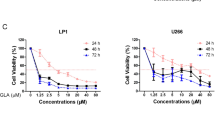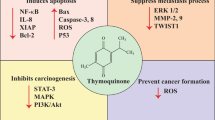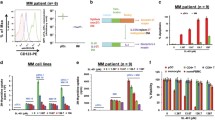Abstract
Several sesquiterpene lactones have been extracted and demonstrated to exert various pharmacological functions in a variety of cancers. Here, we investigated anti-tumor effect of alantolactone, an allergenic sesquiterpene lactone, on human multiple myeloma (MM) and showed alantolactone inhibited growth of MM cells, both in the presence or absence of bone marrow (BM)-derived stromal cells (HS-5), and subsequent G1 phase arrest, and apoptosis as demonstrated by increased Annexin-V/7-AAD binding, caspase-3 or caspase-9 activation and down-modulation of activation of extracellular signal-regulated kinases 1/2. In addition, alantolactone reduced the secretion of MM survival and growth-related cytokines, vascular endothelial growth factor, from MM cells or HS-5 cells, and inhibited cytokine-induced osteoclastogenesis. Notably, alantolactone also inhibited cell proliferation in bortezomib-resistant MM cells. Taken together, alantolactone exerted anti-tumor effect on MM by suppressing cell proliferation, triggering apoptosis, partly damaging the BM microenvironment and overcoming proteasome inhibitor resistance, suggesting alantolactone may be a novel therapeutic approach for the treatment of human MM.






Similar content being viewed by others
Abbreviations
- MM:
-
Multiple myeloma
- ERK1/2:
-
Extracellular signal-regulated kinases1/2
- VEGF:
-
Vascular endothelial growth factor
- BM:
-
Bone marrow
- IL-6:
-
Interleukin-6
- b-FGF:
-
b-Fibroblast growth factor
- HGF:
-
Hepatocyte growth factor
- IGF-1:
-
Insulin-like growth factor-1
- MEK:
-
Mitogen-activated protein kinases
- CML:
-
Chronic myelogenous leukemia
- TSP50:
-
Testes-specific protease 50
- DMSO:
-
Dimethyl sulfoxide
- PI:
-
Propidium iodide
- RNase A:
-
Ribonuelease A
- M-CSF:
-
Macrophage colony-stimulating factor
- sRANK:
-
Soluble receptor activator of NFκB
- ELISA:
-
Enzyme-linked immunosorbent assay
- CDK:
-
Cyclin-dependent kinase
- OC:
-
Osteoclast cell
References
Nair B, van Rhee F, Shaughnessy JD Jr et al (2010) Superior results of total therapy 3 (2003-33) in gene expression profiling-defined low-risk multiple myeloma confirmed in subsequent trial 2006-66 with VRD maintenance. Blood 115:4168–4173
Richardson P, Jagannath S, Hussein M et al (2009) Safety and efficacy of single-agent lenalidomide in patients with relapsed and refractory multiple myeloma. Blood 114:772–778
Richardson P, Anderson K (2006) Thalidomide and dexamethasone: a new standard of care for initial therapy in multiple myeloma. J Clin Oncol 24:334–336
Moreau P (2012) The future of therapy for relapsed/refractory multiple myeloma: emerging agents and novel treatment strategies. Semin Hematol 49(Suppl 1):S33–S46
Ferlin M, Noraz N, Hertogh C, Brochier J, Taylor N, Klein B (2000) Insulin-like growth factor induces the survival and proliferation of myeloma cells through an interleukin-6-independent transduction pathway. Br J Haematol 111:626–634
Freund GG, Kulas DT, Mooney RA (1993) Insulin and IGF-1 increase mitogenesis and glucose metabolism in the multiple myeloma cell line, RPMI 8226. J Immunol 151:1811–1820
Baumann P, Mandl-Weber S, Oduncu F, Schmidmaier R (2009) The novel orally bioavailable inhibitor of phosphoinositol-3-kinase and mammalian target of rapamycin, NVP-BEZ235, inhibits growth and proliferation in multiple myeloma. Exp Cell Res 315:485–497
Koldehoff M, Beelen DW, Elmaagacli AH (2014) Inhibition of mTOR with everolimus and silencing by vascular endothelial cell growth factor-specific siRNA induces synergistic antitumor activity in multiple myeloma cells. Cancer Gene Ther 21:275–282
Jurczyszyn A, Czepiel J, Biesiada G et al (2014) HGF, sIL-6R and TGF-beta1 play a significant role in the progression of multiple myeloma. J Cancer 5:518–524
Hideshima T, Mitsiades C, Tonon G, Richardson PG, Anderson KC (2007) Understanding multiple myeloma pathogenesis in the bone marrow to identify new therapeutic targets. Nat Rev Cancer 7:585–598
Giuliani N, Lunghi P, Morandi F et al (2004) Downmodulation of ERK protein kinase activity inhibits VEGF secretion by human myeloma cells and myeloma-induced angiogenesis. Leukemia 18:628–635
Stojakowska A, Michalska K, Malarz J (2006) Simultaneous quantification of eudesmanolides and thymol derivatives from tissues of Inula helenium and I. royleana by reversed-phase high-performance liquid chromatography. Phytochem Anal 17:157–161
Mi XG, Song ZB, Wu P et al (2014) Alantolactone induces cell apoptosis partially through down-regulation of testes-specific protease 50 expression. Toxicol Lett 224:349–355
Wei W, Huang H, Zhao S et al (2013) Alantolactone induces apoptosis in chronic myelogenous leukemia sensitive or resistant to imatinib through NF-kappaB inhibition and Bcr/Abl protein deletion. Apoptosis 18:1060–1070
Khan M, Li T, Ahmad Khan MK et al (2013) Alantolactone induces apoptosis in HepG2 cells through GSH depletion, inhibition of STAT3 activation, and mitochondrial dysfunction. BioMed Res Int 2013:719858
Shi Y, Bao YL, Wu Y et al (2011) Alantolactone inhibits cell proliferation by interrupting the interaction between Cripto-1 and activin receptor type II A in activin signaling pathway. J Biomol Screen 16:525–535
Zhang Y, Bao YL, Wu Y et al (2013) Alantolactone induces apoptosis in RKO cells through the generation of reactive oxygen species and the mitochondrial pathway. Mol Med Rep 8:967–972
Chun J, Choi RJ, Khan S et al (2012) Alantolactone suppresses inducible nitric oxide synthase and cyclooxygenase-2 expression by down-regulating NF-kappaB, MAPK and AP-1 via the MyD88 signaling pathway in LPS-activated RAW 264.7 cells. Int Immunopharmacol 14:375–383
Seo JY, Park J, Kim HJ et al (2009) Isoalantolactone from Inula helenium caused Nrf2-mediated induction of detoxifying enzymes. J Med Food 12:1038–1045
Franke NE, Niewerth D, Assaraf YG et al (2012) Impaired bortezomib binding to mutant beta5 subunit of the proteasome is the underlying basis for bortezomib resistance in leukemia cells. Leukemia 26:757–768
Vallet S, Raje N, Ishitsuka K et al (2007) MLN3897, a novel CCR1 inhibitor, impairs osteoclastogenesis and inhibits the interaction of multiple myeloma cells and osteoclasts. Blood 110:3744–3752
Green DR, Reed JC (1998) Mitochondria and apoptosis. Science 281:1309–1312
Hengartner MO (2000) The biochemistry of apoptosis. Nature 407:770–776
Yao Y, Zhang YW, Sun LG et al (2012) Juglanthraquinone C, a novel natural compound derived from Juglans mandshurica Maxim, induces S phase arrest and apoptosis in HepG2 cells. Apoptosis 17:832–841
Antonsson B (2001) Bax and other pro-apoptotic Bcl-2 family “killer-proteins” and their victim the mitochondrion. Cell Tissue Res 306:347–361
Morabito F, Gentile M, Mazzone C et al (2010) Therapeutic approaches for newly diagnosed multiple myeloma patients in the era of novel drugs. Eur J Haematol 85:181–191
Shah JJ, Orlowski RZ (2009) Proteasome inhibitors in the treatment of multiple myeloma. Leukemia 23:1964–1979
Orlowski RZ, Kuhn DJ (2008) Proteasome inhibitors in cancer therapy: lessons from the first decade. Clin Cancer Res 14:1649–1657
McConkey DJ, Zhu K (2008) Mechanisms of proteasome inhibitor action and resistance in cancer. Drug Resist Updat 11:164–179
Lim HS, Jin SE, Kim OS, Shin HK, Jeong SJ (2015) Alantolactone from Saussurea lappa exerts antiinflammatory effects by inhibiting chemokine production and STAT1 phosphorylation in TNF-alpha and IFN-gamma-induced in HaCaT cells. Phytother Res
Zhao P, Pan Z, Luo Y et al (2015) Alantolactone induces apoptosis and cell cycle arrest on lung squamous cancer SK-MES-1 cells. J Biochem Mol Toxicol 29:199–206
Chun J, Li RJ, Cheng MS, Kim YS (2015) Alantolactone selectively suppresses STAT3 activation and exhibits potent anticancer activity in MDA-MB-231 cells. Cancer Lett 357:393–403
Yang C, Yang J, Sun M, Yan J, Meng X, Ma T (2013) Alantolactone inhibits growth of K562/adriamycin cells by downregulating Bcr/Abl and P-glycoprotein expression. IUBMB Life 65:435–444
Marsoni S, Damia G (2004) Molecular targeting: new therapeutic strategies to improve tumour apoptosis. Ann Oncol 15(Suppl 4):229–231
Estaquier J, Vallette F, Vayssiere JL, Mignotte B (2012) The mitochondrial pathways of apoptosis. Adv Exp Med Biol 942:157–183
Thornberry NA, Lazebnik Y (1998) Caspases: enemies within. Science 281:1312–1316
Otjacques E, Binsfeld M, Noel A, Beguin Y, Cataldo D, Caers J (2011) Biological aspects of angiogenesis in multiple myeloma. Int J Hematol 94:505–518
Ding JH, Yuan LY, Huang RB, Chen GA (2014) Aspirin inhibits proliferation and induces apoptosis of multiple myeloma cells through regulation of Bcl-2 and Bax and suppression of VEGF. Eur J Haematol 93:329–339
Novack DV (2011) Role of NF-kappaB in the skeleton. Cell Res 21:169–182
Acknowledgments
This work was supported by the National Natural Science Foundation of China (81302034, 81272622).
Conflict of interest
The authors have no conflict of interest to declare.
Author information
Authors and Affiliations
Corresponding authors
Additional information
Yao Yao, Dandan Xia and Yueping Bian have contributed equally to this work.
Electronic supplementary material
Below is the link to the electronic supplementary material.
Rights and permissions
About this article
Cite this article
Yao, Y., Xia, D., Bian, Y. et al. Alantolactone induces G1 phase arrest and apoptosis of multiple myeloma cells and overcomes bortezomib resistance. Apoptosis 20, 1122–1133 (2015). https://doi.org/10.1007/s10495-015-1140-2
Published:
Issue Date:
DOI: https://doi.org/10.1007/s10495-015-1140-2




